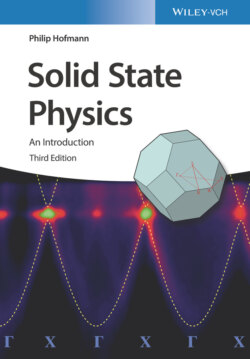Читать книгу Solid State Physics - Philip Hofmann - Страница 28
1.3.1.8 Relation Between Bragg and Laue Theory
ОглавлениеWe conclude our treatment of X‐ray diffraction by showing that the Bragg description of X‐ray diffraction is just a special case of the Laue description. We start by noting that the Laue condition in Eq. (1.25) consists, in fact, of three separate conditions for the three components of the vectors. In the Bragg experiment, two of these conditions are automatically fulfilled because of the specular geometry: The wave vector change parallel to the lattice planes is zero. So, the vector Equation 1.25 reduces to the scalar equation
(1.30)
where is a reciprocal lattice vector perpendicular to the lattice planes. We have seen in Section 1.3.1.4 that such a reciprocal lattice vector exists for any set of planes. The planes can be defined by their Miller indices or by the reciprocal lattice vector that is perpendicular to the planes (see Problem 9). The shortest possible has a length of with being the distance between the planes, but any integer multiple of this will also work. Thus, if we insert for into Eq. (1.30), we obtain the usual form of the Bragg condition in Eq. (1.3).
